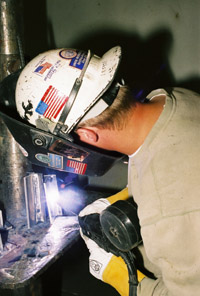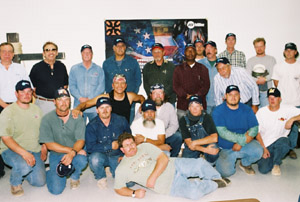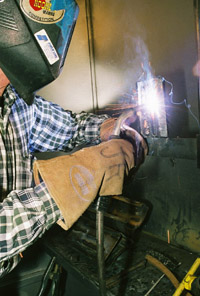Ironworkers donate time to museum affiliated with Smithsonian to weld giant dinosaur.
Every now and then, forward thinking requires taking an enormous step back in time. For the Las Vegas Ironworkers Union Local 416/433, building a dinosaur has not only broadened their skill sets but has generated more work and fostered goodwill throughout the community. Until recently, the Ironworkers were largely limited to structural steel jobs that required the Stick or flux cored welding processes to build high rises, schools and bridges. However, with proper training and extensive volunteer efforts, they are learning to work with a variety of metals to ensure more local jobs, including the erection of an aluminum replica of an Argentinosaurus, most likely the largest dinosaur discovered to date (estimated weight: 100 tons).
Because much of the work in Las Vegas requires working with miscellaneous metals, or ornamental iron, union Ironworkers need skills that fulfill these types of jobs to retain and acquire work. In the past, Ironworkers lost jobs to other trades because jurisdictional work was being awarded to trade groups with diversified welding skills. Further, Ironworker facilities were not equipped for working with miscellaneous metals. While contractors do have an allegiance to a particular trade, they also need to hire workers who can get the job done no matter what trade they belong to. And once the work is sent elsewhere, it's hard to get back.
 |
|
To weld aluminum using the MIG process, the Ironworkers of Local 416/433 learned that using a spoolgun provides better feeding performance than standard benchtop feeders.
|
Now, as more jobs include such exotic work as stainless steel hand railing and statues in malls and hotels, Ironworkers seek to expand their skills. To help, union facilities have diversified their offerings to Local members in an effort to train them. Now, when contractors come to the hall looking for help on a particular project, they can man the job with qualified people.
Groundwork
As part of the effort, the Field Ironworkers Apprenticeship and Retraining Center for Locals 416/433 conducted a pilot training class in October 2003. The class began after a contractor, doing work in a local mall, needed trained men to weld stainless steel for a hand railing project. Local 416/433 members wanted to broaden their skills to fulfill this type of work, as well as other jobs. So what began as fulfilling one contractor's need has developed into a variety of unconventional applications, such as the 75-foot long, 20-foot tall aluminum Argentinosaurus exhibit. When complete, the dinosaur will stand permanently outside the Las Vegas Natural History Museum, a Smithsonian affiliate.
When Marilyn Gillespie, executive director of the museum, approached the Field Ironworkers Apprenticeship and Retraining Center for help, it was clear she had very large plans-and very little funds-for building the dinosaur. Even Fred Baptiste, coordinator for the Ironworker program in Las Vegas, knew the project would be challenging. Concerns about cost and time involved in such a large project seemed overwhelming, but with the help Miller Electric Mfg. Co., a long-term vision materialized. The project would require considerable training and a sincere willingness to donate time and hard work on behalf of the community.
First, the Ironworkers needed to broaden their skills. Miller provided the welding expertise and training by custom developing the curriculum and teaching the class. For the Ironworkers of Locals 416/433 Apprenticeship, one of the first Ironworker facilities in the country to get involved in this type of program, training meant progressing beyond the FCAW (flux cored arc welding) and SMAW (shielded metal arc welding, or Stick) welding techniques used on steel structures. New processes they learned included GMAW (gas metal arc welding, or MIG) and GTAW (gas tungsten arc welding, or TIG) aluminum and stainless steel. For many of the members, this was their first experience working with these types of processes and metals.
 |
|
Twenty-one Ironworkers of Local 416/433 participated in four days of MIG and TIG welding training to increase their ability to work on ornamental iron.
|
"They're structural guys," said Baptiste. "Most of their work is 'blow and go' and their welds are covered by a building. However, the welds on the dinosaur will be exposed for all to see, plus you're talking lots of money for the material they're welding on."
For the exposure, many Ironworkers had to "undo" 20 years of working with primarily shielded metal and flux cored arc welding processes. As a result, a major part of their instruction covered the different types of welding equipment available for doing ornamental iron work. Next, they learned how equipment to set up equipment to perform particular welding processes, such as changing from reverse to straight polarity when transitioning from MIG to TIG. Classroom training focused on dealing with the characteristics of the material itself, including melting temperatures, dos and don'ts and cleaning guidelines.
 |
|
Part of the Ironworkers' training involved learning how to select the right shielding gas. This Ironworker MIG welds with solid stainless steel wire using a tri-mix gas mixture of helium, argon and CO2.
|
Ironworkers were given the opportunity to work with sophisticated equipment and learn new technology in the classroom. Considering many exotic jobs include working with aluminum, and the dinosaur would be constructed from all aluminum tubing, Miller spent a great deal of time teaching students how to weld MIG aluminum with Miller XMT¦reg; CC/CV (multi-process) inverters and Spoolmatic¦reg; 30A spool guns. For welding stainless steel, they paired the XMTs with 22A bench top-style feeders.
For TIG welding on aluminums, the Ironworkers used Miller Syncrowave¦reg; 250 DX AC/DC TIG power sources. Instructors ran a Millermatic¦reg; 251 all-in-one MIG welder with McKay¦reg; stainless steel 308L flux cored wire on some heavier materials and McKay stainless steel solid electrodes for light gauge materials.
Instruction on solid wire centered on such items as the differences between push and pull gun techniques (always push aluminum) and on how the outcome of the weldment relies on the welder's ability to identify and understand how the machine needs to be set for a particular application. For example, aluminum wires don't perform well using short circuit transfer. They perform best in spray transfer mode and it takes sufficient voltage and amperage to create a spray transfer mode. Spray transfer works well for heavier materials. However, aluminum thinner that about 1/8-in. can't tolerate the heat of spray transfer, so TIG welding may be recommended.
Beyond welding techniques, Ironworkers focused on the mechanics of the equipment and parts. In one of the booths, instructors staged a piece of welding equipment and spool gun and left a TIG torch hanging. Ironworkers had to remove the spool gun, put on a TIG torch, get an arc on the torch, removed the TIG torch, put the spool gun back on and strike another arc. By physically taking the equipment apart and putting it back together, the Ironworkers not only understood how they made mistakes (typically the wrong polarity) but also learned how to correct them, not to mention how to set up the equipment on their own.
The equipment training wouldn't be effective without a full understanding of the properties of the various metals used. Through charts that display the various properties of miscellaneous metals, as well as the equipment and settings that should be used to weld on the metals, the Ironworkers became well versed on melting temperatures, cleaning and shielding gas. They may have already known that the shielding gas used in steel welding is 75% argon and 25% CO2 (commonly called "75/25" or "C25"), but they learned that solid wire stainless steel requires a "tri-mix" gas that consists of 90 percent helium/7.5 percent argon/2.5 percent CO2. For flux cored stainless, 75/25 will work well because there are oxidizers and additives in the flux that remove contaminative oxygen. However, for TIG welding stainless, only an inert gas, such as argon, is used. For more penetration, helium may be added.
Looking Ahead
Miller donated time and expertise to the training program so that instructors from the Ironworker facility can eventually develop their own curriculum. All instructors from Locals 416/433 attend the classes and expect to take over the teaching at some point. Classes run for four days, 4-8 p.m., with an optional fifth day. While the class doesn't generate a weld certification, it does help Ironworkers to prepare for it and provides them with the skills to perform a number of miscellaneous metal jobs that don't require certification, including the dinosaur.
|
|
|
To learn how to set up equipment properly, the Ironworkers' training included tearing down a system set up for MIG welding, connecting the proper equipment for TIG welding and successfully striking a TIG arc (shown here).
|
To become certified, Ironworkers attend classes at the center, which is accredited with the National Ironworkers Welding Certification Program and overseen by the American Welding Society (AWS). With the help of Ed Abbott of the Ironworkers National Training Fund and Mike McDonald, AWS assessor for the Ironworkers National Welding Certification Program, the school already offers a flux cored stainless steel certification and plans to put aluminum and stainless TIG certifications in place. Further, the school's four-year apprenticeship program is accredited to the community college. The union pays for tuition and books, and at the end of the program, most apprentices are just a couple of classes short of finishing their college degree.
Community Support
The training and materials come with some costs attached, of course. Gene Vick, director of the State of California Ironworkers Apprenticeship, and Dick Zampa, president of the Ironworkers District Council, State of California and vicinity, have offered support and allowed for funds to cover some of the equipment and materials involved in the training. Notably, the time the Ironworkers devote to the classroom and building the dinosaur is all voluntary, but the project still requires financing. For a private, non-profit museum, summoning community resources for the dinosaur has been more challenging.
"We are a young museum in a community not known for its philanthropy," said Gillespie. "This is the toughest market in the world for museums because we're in the entertainment capital of the world. We take a backseat to the things that happen on the Strip, but the kids here (and we're a community of 1.5 million people (deserve to have the same kind of resources that kids in other cities do."
Materials haven't come easy either, particularly with a shortage of aluminum in Las Vegas. While aluminum for the project was eventually donated, many contractors rejected the museum's requests for materials. Although the project had a rough start, the Ironworkers' support and enthusiasm for a community service project is helping the dinosaur finally coming together.
"Because we receive no public funds, it is absolutely necessary for this museum to go into the community for support for all of our projects, which is what I've done with the Ironworkers and this dinosaur project," said Gillespie.
The Public Eye
The Argentinosaurus was originally built for a traveling exhibit, and Las Vegas, as the last stop, seemed like a good place to retire at least some of the pieces. Gillespie petitioned the Los Angeles County Natural History Museum and received the head and parts of the body-a good start. She felt the exhibit needed a more definitive, life-like shape that could be achieved only by completing the sculpture. The dinosaur will be completed in three phases, starting with the fabrication, which will be done primarily at the Ironworkers' training facility. From there, it will be taken to the museum where it will be assembled and finally welded into place.
In the end, the aluminum dinosaur, with a new backbone and tail, will stand outside supported by steel "trees." Because it must withstand the elements-and the birds-the Ironworkers will use their aluminum welding skills to weld and cap off the open tubes to prevent rain damage and birds from nesting in them. While there is no official date for completion, there will be a high-profile unveiling at the museum, where an official press conference will include the mayor, city councilmen and one very large dinosaur.
"This thing is so huge that you'll be able to see it coming down the street," said Baptiste. "This thing is going to stand out. It's not hidden, it's not covered up-it's going to be exposed." For the Ironworkers who only used to weld steel, the exposure is a huge step forward toward showcasing their new welding skills.